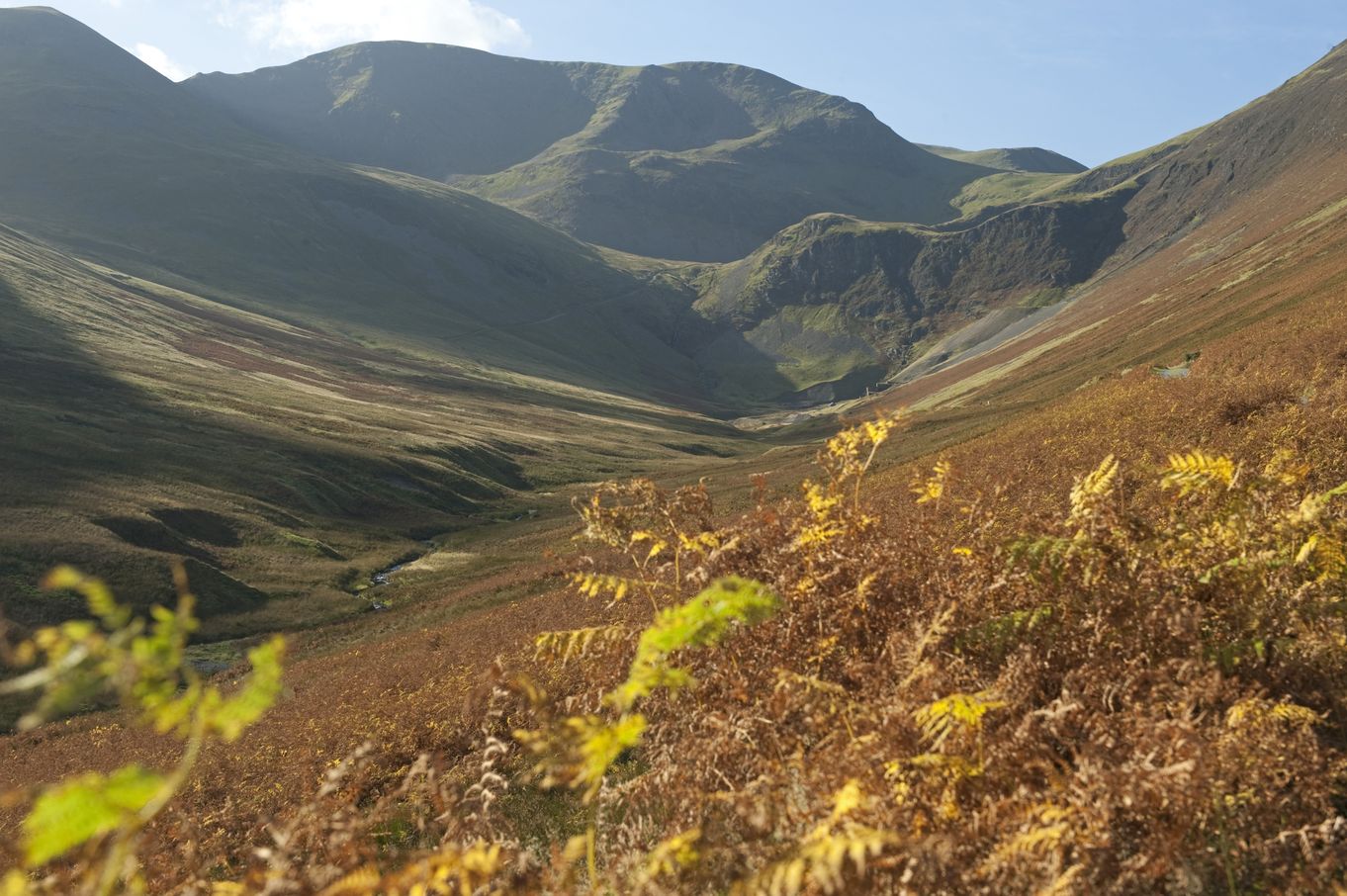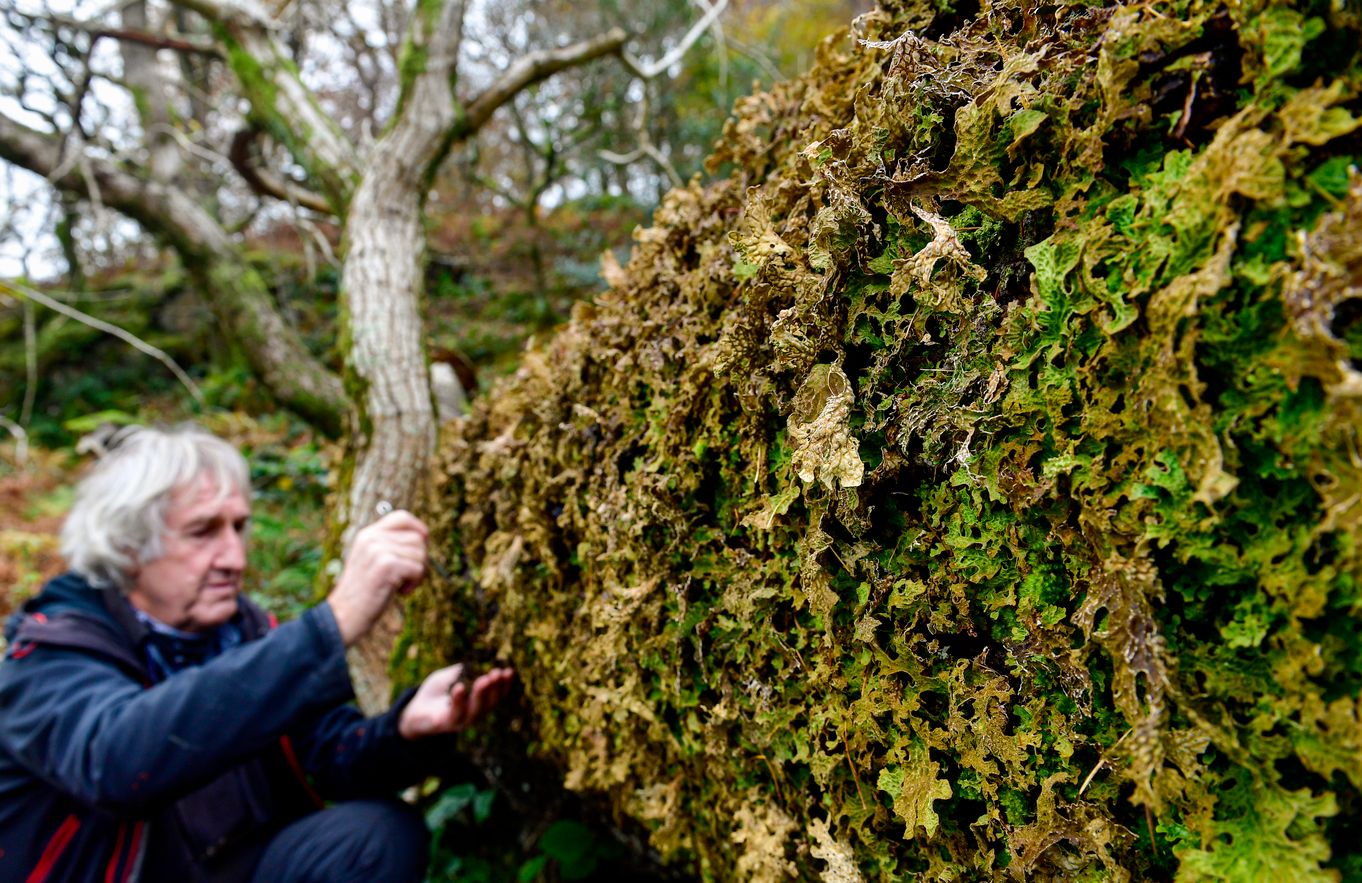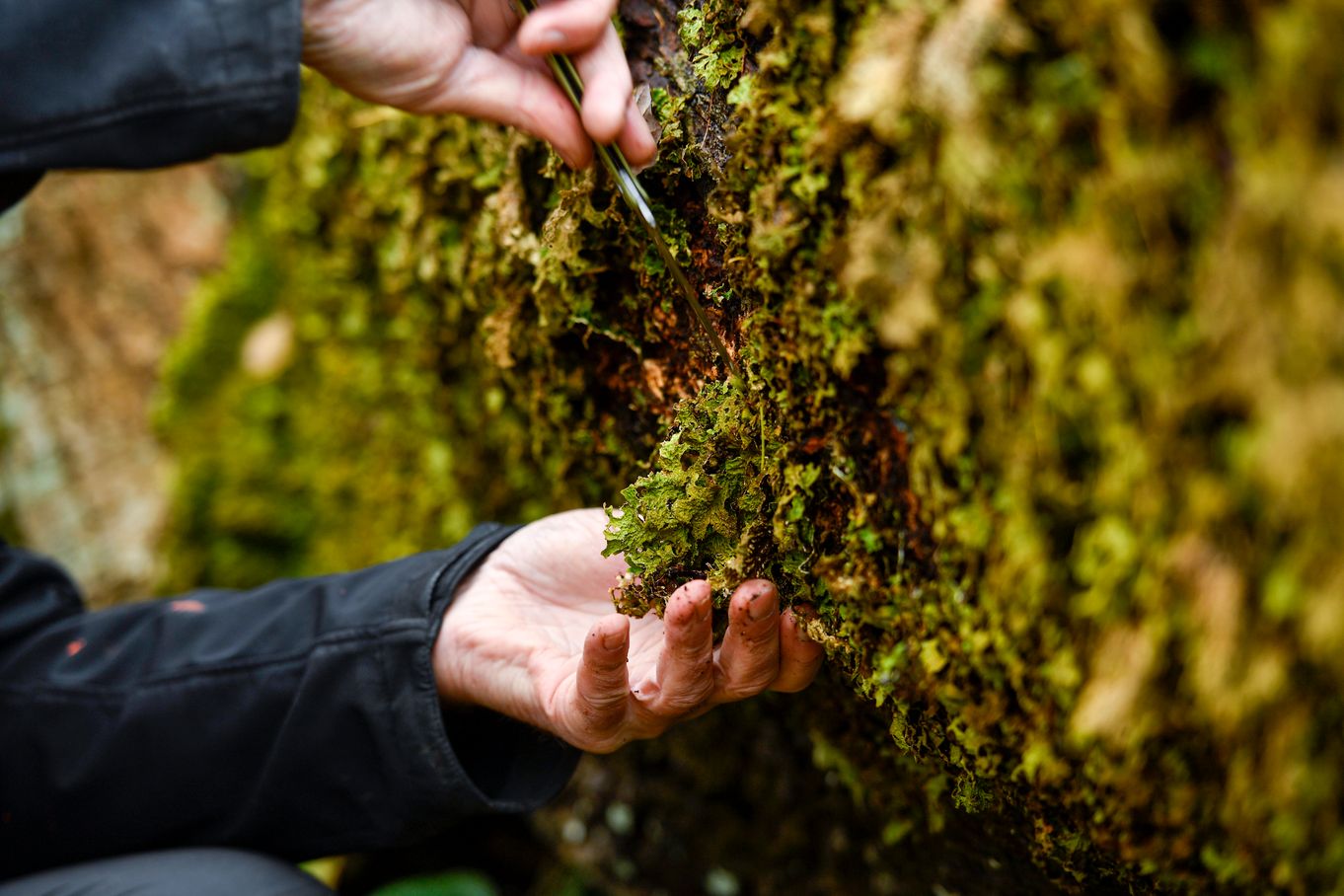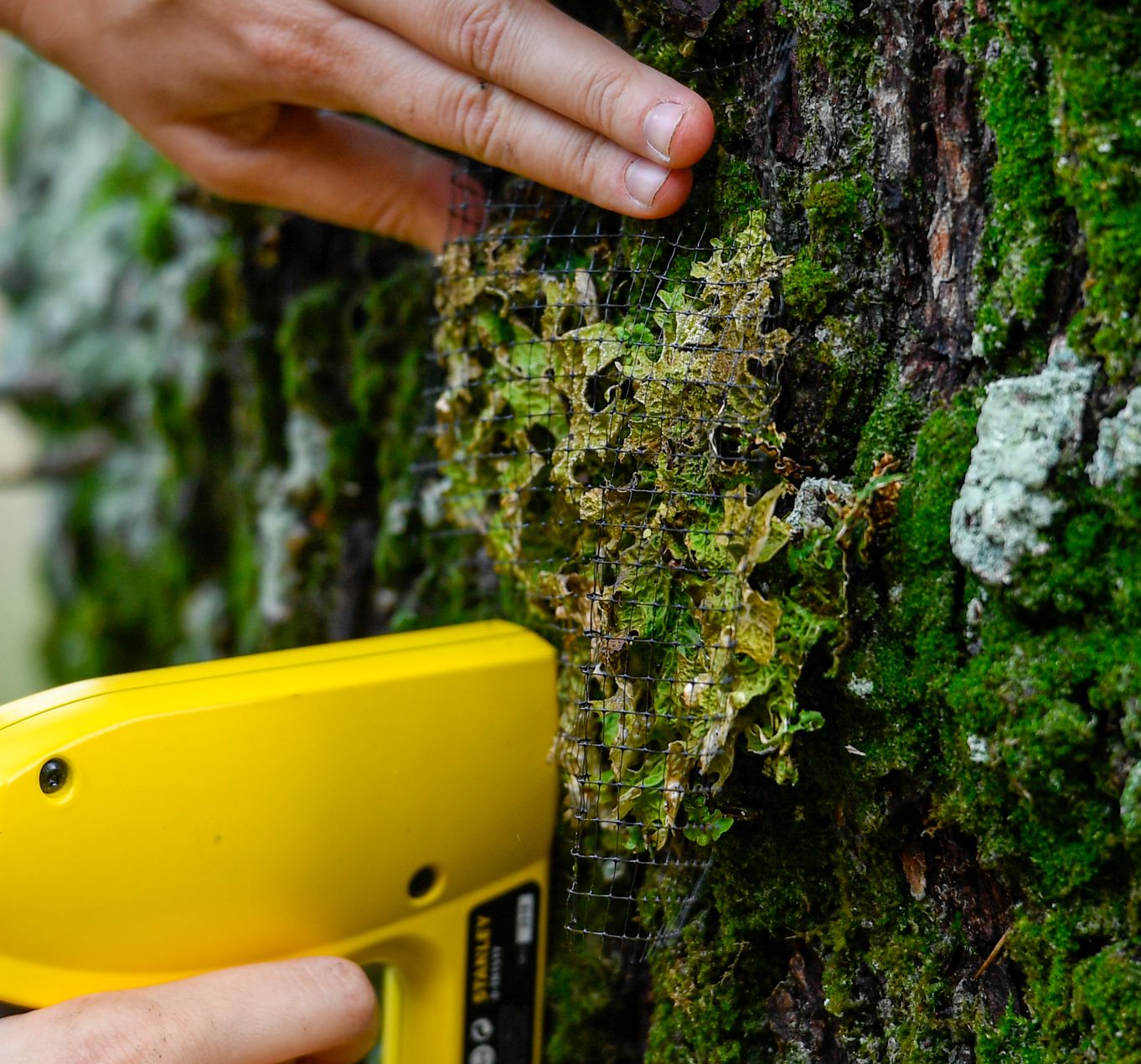Charity Attempts Largest Transplant Of Ancient And Rare Lichen In Efforts To Protect Its Future
The National Trust is attempting to save one of England’s rarest ancient lichens by removing it from a fallen veteran oak tree in the Lake District and transferring it to dozens of nearby trees.
The lungwort lichen, Lobaria pulmonaria, a characteristic of the wildwoods that started establishing after the last ice age, has become increasingly rare in England since the 18th century as a result of air pollution and habitat loss.
Although historically prolific, this old growth species of lichen is currently surviving at only a handful of sites in the Lakes where its presence has traditionally been an indicator of a healthy woodland.
The process, known as translocation, involves carefully removing it from the host tree, before reattaching to new trees by a range of means including wire mesh to hold it in place, staples or even glue. Without doing this, the lichen would die.
The transfer is the largest ever attempt made by the National Trust in partnership with the British Lichen Society, Cumbria Lichen & Bryophyte Group and Plantlife, almost three square metres was removed and transplanted on dozens of different trees across Borrowdale, resulting in over 100 translocations.
The translocation method has previously worked for other lichen species, but in general there is a very low success rate for Lobaria, outside of Scotland. The lichen needs plenty of light and water to help it establish and grow and with Borrowdale being an extensive area of woodland, and the wettest inhabited place in England - with regular levels of rainfall of over 3.5 metres each year - there is plenty of suitable habitat.
The lungwort lichen had been living on a veteran oak tree in the Borrowdale valley, thought to be between 200-300 years old, until the tree blew down in storms earlier this year.
The tree is thought to have held one of the single largest communities of Lobaria pulmonaria anywhere in England and demonstrates the vulnerability of some of the endangered species cared for by the conservation charity.
Maurice Pankhurst, Woodland Ranger at the National Trust says: “The communities of lichens and bryophytes in Borrowdale is one of the finest in northern Europe. Just as an art gallery would protect their collection of fine and rare paintings, it’s essential for us to protect these rare species.”
Ecologists and scientists have been monitoring the tree since it fell and have been locating suitable receptor trees to transplant the material. This has been completed as quickly as possible (within COVID restrictions) before the wood started to deteriorate - identifying several veteran oaks, ash, sycamore and hazel trees as suitable receptors.
The selected trees are scattered across different parts of the valley in an attempt to encourage the lichen to help make the Lake District population as resilient as possible to landscape scale threats, such as tree diseases, air pollution and climate change.
April Windle, Cumbria Lichen & Bryophyte Group member, has been studying the tree for three years, and championed the translocation attempt.
She says: “Lichens are such amazing lifeforms and play such a fundamental role within these woods. They photosynthesise, regulate water and carbon cycles, provide food for invertebrates and nesting material for birds. They are also ecosystem pioneers - the first organisms to colonise bare surfaces, changing the baseline environmental conditions which allow other wildlife to move in and thrive.
“The presence or absence of certain lichen species can be used to indicate the health of the ecosystem in which they are found. Lichens act as early warning signals for future changes that are about to come, due to their sensitivity to any disruptions in their environment.”
The translocation team used various techniques to attach the Lobaria to the recipient trees in an effort to research which might be the most successful. This included attaching the lichen to the host tree using wire mesh to hold it into place, using staples, gluing it into place using eco-friendly glue, and rubbing the reproductive propagules of the lichen directly onto the bark and moss.
April continues: “Previous translocation attempts vary in their success rate, with the main reasons for failure being mollusc grazing or unsuitable habitat choice. We’ve deliberately translocated high up on the trunk out of harm’s way of hungry slugs/snails and positioned the Lobaria to receive maximum light and moisture. This was predominantly on the southern side of the trunk, on the transition zone between the more open bark and moss dominated area.
“We hope, that with assistance of mesh, staples and glue, the lichen will eventually attach, become independent and reproduce. Only time will tell with a project like this whether the Lobaria will establish in its new home or not. Detailed information for each transplant has been recorded, so we can monitor and note reasons for any successes and failures.”
Lobaria has rapidly declined across Europe due to historic pollution such as sulphur dioxide, alongside more recent changes such as increase in nitrogen. There has been a huge effort to greatly reduce emissions across Europe over the past 30 years, with sulphur levels falling significantly after the Clean Air Act (1956) was implemented.
Maurice Pankhurst continues: “It is hard to believe now but it is thought that Keswick was once home to the largest copper smelting complex in northern Europe and with it came significant air pollution.
“Although the impact of acid rain has declined, nitrogen pollution is now more of a problem, arising from increased road vehicles and intensive agriculture, which is having a huge impact on these Atlantic woodlands and the old growth lichens which need very clean air to thrive. This is particularly pertinent after this summer when we witnessed increased numbers of visitors to the Lake District after lockdown restrictions eased.”
Maurice added: “Often described as Celtic rainforests, these Atlantic woodlands are internationally important and part of the natural heritage of our country and crucial in understanding the impact of environmental change.
“Without our active conservation, we risk losing species like lungwort before we have had time to understand the subtle interconnections between the different species that keep these beautifully rich Atlantic woodlands in a healthy condition, and even how they can help influence our own human development.”
To make a donation to support the National Trust’s conservation work which includes protecting biodiversity and tackling climate change, visit www.nationaltrust.org.uk




